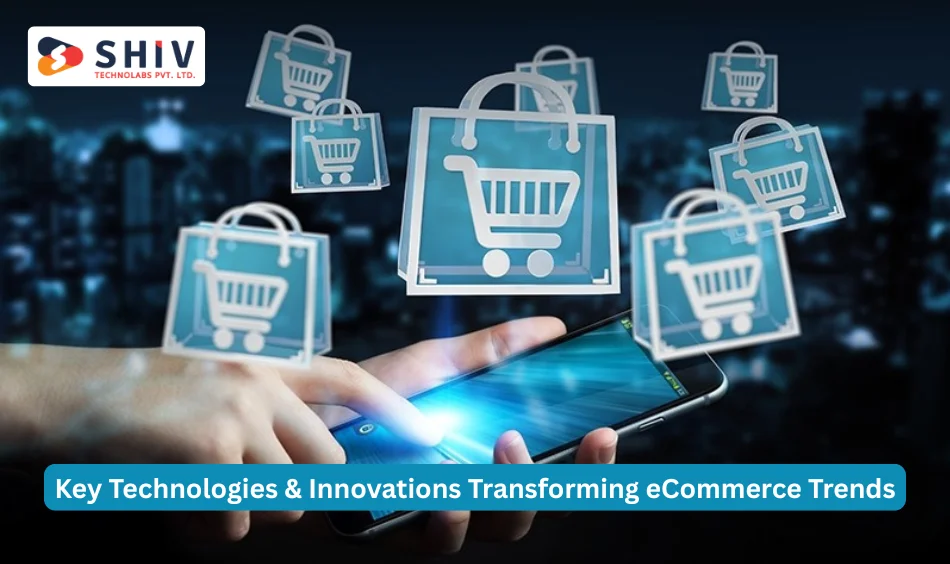Table of Contents
eCommerce is changing the way people buy online products and how companies do business. The rise of online stores has brought new ideas and fresh approaches that influence buying habits. As technology advances, companies need to keep up with the latest trends in ecommerce to stay ahead. This blog will help you understand the most important changes, technology shifts, and what the future of digital commerce looks like.
eCommerce Market Outlook 2025: Current State and Key Drivers
By the end of 2025, the global eCommerce market is expected to reach about $6.86 trillion, reflecting an 8.37% increase from 2024. This rise comes from more people using smartphones, the ease of shopping online, and the spread of digital payment methods.
Online shopping has moved from a choice to a daily routine for many. Businesses see rising numbers of digital buyers every year. The rise of digital shopping has pushed companies to adjust the way they serve customers. Fast delivery, safe payment options, and tailored shopping experiences are now basic requirements.
As the market grows, trends in ecommerce point to a move toward personal touches, environmentally friendly products, and the use of data in marketing. The future of commerce will rely on meeting new customer needs and adopting new technology, making this an important moment for businesses to invest in eCommerce development and use the latest eCommerce technology for online stores.
Key Technologies & Innovations Transforming eCommerce Trends

The future of digital commerce is shaped by groundbreaking advancements that change the way people shop and how businesses operate. Many technology trends now play a major role in eCommerce, allowing brands to give shoppers more personal and engaging experiences. The latest innovations are setting new directions for ecommerce trends in 2025.
1. AI-driven personalization: The New Standard for Online Stores
Artificial Intelligence (AI) is one of the top eCommerce trends to invest in. Many online stores now use AI to suggest products, answer customer questions, and improve the shopping journey. AI-driven chatbots give instant replies, helping buyers make quick choices. Personalized product recommendations increase sales and make shopping more fun.
- Tailored Recommendations: AI studies what customers do, what they buy, and how they browse to suggest items each person is more likely to want.
- Targeted Marketing: AI reviews large amounts of data to create focused marketing campaigns, sending offers and messages that match each customer’s preferences.
- Real-Time Adjustments: Personalization tools adjust instantly, showing different homepages, banners, and deals for each visitor.
Also Read: 10 AI-Powered Features Every Modern eCommerce Website Needs
2. Conversational Commerce Changes the Way We Buy Online
Conversational commerce is changing the way people interact with online stores. Chatbots and voice assistants make it possible for shoppers to get instant help, ask about product details, and even place orders using natural language. These tools are always available, giving fast answers and guiding buyers through every step.
- Chatbots for Instant Support: Smart chatbots handle questions, suggest products, and can even complete orders through live chat.
- Voice-Driven Shopping: Voice assistants, such as Alexa and Google Assistant, allow users to search for products, make purchases, and check order status with simple voice commands.
- 24/7 Service: Automated tools keep online stores open around the clock, making shopping convenient at any time.
Also Read: 20 Best Practices For Integrating AI Chatbots With Your Business
3. Augmented Reality & Virtual Shopping Brings Products to Life for Online Shoppers
Augmented Reality (AR) supports customers as they choose what to buy. With AR, shoppers can use their phones to see how products would look in their homes or on themselves. For example, someone can check how a sofa fits in their living room or see how a pair of glasses looks on their face. This technology helps people feel more confident about their choices when shopping online.
Virtual showrooms and 3D product views are also gaining ground. These features set a new standard for the trends of online shopping and make the buying process more interactive. AR is one of the latest trends in the commerce industry, letting brands stand out and connect with buyers on a deeper level.
4. Headless Commerce Delivers Fast and Seamless Shopping
Headless commerce is changing how online stores work. By separating the front-end (what customers see) from the back-end (where data and systems run), businesses gain more flexibility to shape the shopping experience.
- Flexible User Experiences: Brands can quickly update website designs, launch new digital platforms, or create custom apps to serve their customers in better ways.
- Faster Innovation: Developers can add new features and make changes quickly, allowing stores to keep up with trends in ecommerce without long wait times.
Also Read: The Ultimate Guide to Shopify Headless Commerce Development
5. Generative AI Shapes the Next Wave of Online Retail Innovation
Generative AI models, such as advanced language generators, are changing how retailers produce content.
- Dynamic Content Creation: Generative AI writes product descriptions, blog posts, and marketing messages that feel human and unique.
- Personalized Marketing: Retailers send emails, ads, and recommendations created by AI for each customer segment or even individual buyers.
- Visual Design: Generative AI tools help produce custom graphics, banners, and promotional visuals, speeding up campaign launches.
As a result, generative AI is recognized among the latest trends in the commerce industry. It gives brands a creative advantage and helps them attract more attention in a busy market. By bringing in these new technologies, companies can offer better shopping experiences, grow their sales, and build stronger customer relationships.
Consumer Behavior & Shopping Trends in eCommerce

Online shopping habits continue to shift as technology and social platforms influence buyer expectations. Shoppers now look for convenience, value, and trust. This shift drives trends such as social commerce, eco-friendly products, and mobile-first shopping. Businesses that keep up with these changes build stronger connections and drive steady growth.
6. Social Commerce: Shopping Directly on Social Media
Social commerce makes it possible for users to shop where they already spend time—on their favorite social platforms. This approach lets people browse and buy products without leaving apps like Instagram or TikTok.
- Platforms like Instagram and TikTok offer in-app shopping and product tags.
- Live shopping events and influencer partnerships boost product visibility.
- Shoppers move smoothly from discovery to purchase, driving more impulse buys.
- Brands reach buyers right where they are most active.
7. Sustainable Shopping: Eco-Friendly Choices on the Rise
Consumers now seek products that do less harm to the environment. Brands with clear, responsible practices win trust and keep loyal customers.
- Eco-friendly goods and recycled materials are in high demand.
- Transparent supply chains and clear labeling influence buyer choices.
- Carbon-neutral shipping and green packaging stand out.
- Sustainability is a key factor in building brand loyalty.
8. Second-Hand Marketplaces: The Growth of Resale Shopping
Buying and selling pre-owned goods is more popular than ever. These marketplaces help people save money and support the environment. Resale platforms are gaining ground, as more buyers choose pre-owned goods for both cost and sustainability reasons.
- Easy-to-use apps and websites connect buyers and sellers.
- High-quality brands become more affordable through resale.
- Circular economy reduces waste and promotes reuse.
- Shoppers value saving money and making eco-friendly choices.
9. Subscription Models: Regular Deliveries That Build Loyalty
Subscription shopping brings convenience and helps brands build stronger connections with their customers. Subscription-based shopping has become more common, especially in sectors like food, beauty, and wellness. Customers sign up for regular deliveries of products they use often, such as coffee, skincare items, or pet supplies.
- Regular deliveries for items like food, beauty, or pet supplies.
- Stores enjoy predictable revenue and improved customer retention.
- Shoppers never run out of essentials and discover new favorites.
- Curated subscription boxes keep the shopping experience fresh.
10. Mobile-First Shopping: Designing for Small Screens
Most online shopping now happens on mobile devices. Brands succeed by focusing on mobile-friendly design and features. Businesses have responded by making their websites and apps easy to use on phones and tablets.
- Fast load times and easy checkout keep shoppers engaged.
- Mobile wallets and one-click payments make buying simple.
- Touch-friendly layouts improve user experience on phones and tablets.
- In-app notifications and personalized offers boost sales and engagement.
- Data-Driven Strategies & SEO for eCommerce in 2025
The future of digital commerce relies on smart strategies that blend data, technology, and search optimization. As online competition grows, these methods help businesses boost visibility, reach the right buyers, and build trust.
11. Core Web Vitals Optimization
Website speed and performance now have a direct impact on both user experience and search rankings. Core Web Vitals focus on key areas: loading time, interactivity, and visual stability. When a page loads quickly and responds smoothly, visitors stay longer and are more likely to make a purchase.
- Compress images to lower load times.
- Minimize server response delays.
- Reduce the use of heavy scripts.
- Monitor loading, input delay, and layout shift scores regularly.
12. Voice Search Optimization
The rise of voice assistants has changed the way people search for products and services. Shoppers now use natural language and longer phrases when speaking to devices. To keep up, online stores need to adjust their SEO strategies for voice search.
- Use long-tail and conversational keywords in content.
- Answer common questions clearly (FAQs).
- Add local keywords to attract voice-driven traffic.
- Keep product descriptions simple and direct.
13. User-Generated Content (UGC)
Content created by real customers builds trust and authenticity. User-generated content includes product reviews, ratings, photos, and testimonials. Shoppers trust the opinions of other buyers more than brand claims, so UGC directly influences buying decisions.
- Encourage customers to leave product reviews.
- Showcase buyer-submitted photos and testimonials.
- Respond to customer feedback publicly.
- Feature top UGC on product and landing pages.
14. Structured Data & Schema Markup
Adding structured data tags helps search engines display rich snippets, making listings more eye-catching and informative.
- Mark up product details: price, rating, stock status.
- Use a schema for reviews and FAQs.
- Test schema markup with Google’s Rich Results tool.
- Update the markup as product details change.
15. AI-Driven SEO
AI tools quickly spot search trends, optimize content, and automate updates for stronger results.
- Use AI to research new keywords and topics.
- Let AI suggest content improvements and metadata tweaks.
- Monitor competitor rankings and search performance with AI insights.
- Automate regular SEO health checks and updates.
Using these focused strategies, online businesses stay visible, gain trust, and respond quickly to changing ecommerce trends in 2025.
Global & Regional Market Dynamics for eCommerce
eCommerce growth in 2025 is driven by changing strategies and local market demands. Here are four key trends shaping the future of commerce worldwide:
16. Cross-Border eCommerce
Selling across borders is now common, but success requires adapting to new markets and offering varied payment methods.
- Localize content, currency, and language for target regions.
- Comply with local tax and import rules.
- Offer popular local payment options (cards, wallets, UPI, etc.).
- Address cross-border shipping and delivery challenges.
17. Direct-to-Consumer (D2C) Growth
Brands skip middlemen to connect directly with buyers, building loyalty and gathering valuable customer insights.
- Launch branded eCommerce stores or apps.
- Control product presentation, pricing, and promotions.
- Gather direct feedback from buyers for fast product improvement.
- Increase margins by reducing reliance on third-party retailers.
18. Unified Payments Interface (UPI) Adoption
UPI is transforming digital payments in markets like India, making online transactions fast, secure, and widely accessible.
- Offer UPI as a checkout option to reach more Indian shoppers.
- Support instant, cashless transactions with lower fees.
- Build trust with safe, familiar payment processes.
- Track the growing trend of UPI adoption in other emerging markets.
19. Rural Market Penetration
Online platforms are now reaching rural buyers, unlocking new growth by serving underserved regions.
- Develop mobile-friendly, low-bandwidth websites and apps.
- Expand logistics and delivery services to non-urban locations.
- Partner with local agents for last-mile delivery and support.
- Create special offers or payment plans for rural customers.
These market dynamics help businesses respond to local needs, support global expansion, and stay competitive in the fast-changing landscape of ecommerce trends.
Stay Ahead of eCommerce Trends with Shiv Technolabs
Keeping up with the latest trends in ecommerce is essential for any business that wants to grow in today’s fast-moving market. Shiv Technolabs offers tailored digital commerce solutions designed for modern online stores. Whether you run a small shop or a large enterprise, our team helps you use new technology and smart strategies to reach more customers.
Why Choose Shiv Technolabs?
- Custom eCommerce Platforms: Get a store built for your brand’s needs, supporting easy updates and growth.
- Advanced Technology Integration: Use AI, AR, and automation to improve shopping experiences and drive more sales.
- Mobile & Global Readiness: Reach buyers on any device, and adapt your store for different languages, currencies, and regions.
- Full Support for Payment Methods: Accept global and local payment options, including UPI, digital wallets, and more.
- Ongoing Support & Updates: Stay current with trends of online shopping and the latest eCommerce technology for online stores.
We give your business the tools and support to stand out in the changing world of digital commerce. Let our experts guide you through every step, so you can focus on serving your customers and growing your brand.
Conclusion
eCommerce evolves quickly, with new trends and shopper habits shaping the future of digital commerce. Adopting top eCommerce trends and the latest technology helps businesses stay strong and flexible.
If you want to keep your online store up to date, Shiv Technolabs provides expert support and digital commerce solutions for any size business. Our team helps you use the best trends in ecommerce to reach your goals and grow with confidence. Get in touch with us now!

























